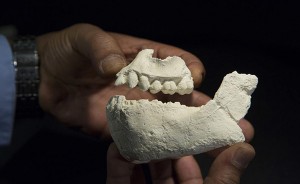Prehistoric Lucy Had Neighbors
June 10, 2015
Fossilized jaws and teeth discovered in northern Ethiopia belong to a previously unknown ancient human ancestor that lived 3.3 million years ago, according to scientists who announced the discovery in late May 2015 in the journal Nature. The new species, named Australopithecus deyiremeda by the scientists who described the fossil remains, lived at the same time and in the same region as another early human ancestor.

Yohannes Haile-Selassie, a paleoanthropologist at the Cleveland Museum of Natural History, holds casts of the jaws of Australopithecus deyiremeda, a new human ancestor species from Ethiopia. (Credit: Laura Dempsey, Cleveland Museum of Natural History)
The Ethiopian anthropologist Yohannes Haile-Selassie of the Cleveland Museum of Natural History in Ohio described the fossils, which were found at a site in the Afar region of northeastern Ethiopia. The scientists concluded that the fossils are from an early hominin. Hominins, also called hominids, are the scientific family that includes human beings and early humanlike ancestors. The site is about the same age and only a few miles from Hadar, where fossils of Australopithecus afarensis were first discovered by the anthropologist Donald C. Johanson in 1974. A. afarensis was an early humanlike creature known in part from a famous fossil skeleton nicknamed “Lucy.” The two species are similar in their anatomy, but they can be distinguished by different shaped jaws. Haile-Selassie believes the fossil jaws and teeth belong to the same species as several fossil foot bones that were discovered at a nearby site in Ethiopia and described in 2012.
The scientists believe the fossils demonstrate that Lucy and her kind were only one of perhaps several hominin species that inhabited the forests and grasslands of East Africa more than 3 million years ago. Each species was adapted to a different habitat and likely had different anatomy and behavior, including how it moved around. However, scientists are not certain if any of these species are direct ancestors to modern humans.
Paleoanthropologists speculate that the distinct jaw shapes of A. deyiremeda and A. afarensis could mean that they used their teeth on different kinds of food. This means that the two species could have lived side-by-side, because they would not have directly competed for food, shelter, and territory. However, not all scientists agree that these new fossils represent a new species of hominin. Some scientists think that the fossils simply demonstrate that physical variation was great among A. afarenis.
Other World Book articles:
- Anthropology (1973-a Back in time article)
- Anthropology (1983-a Back in time article)
- Anthropology (2012-a Back in time article)


